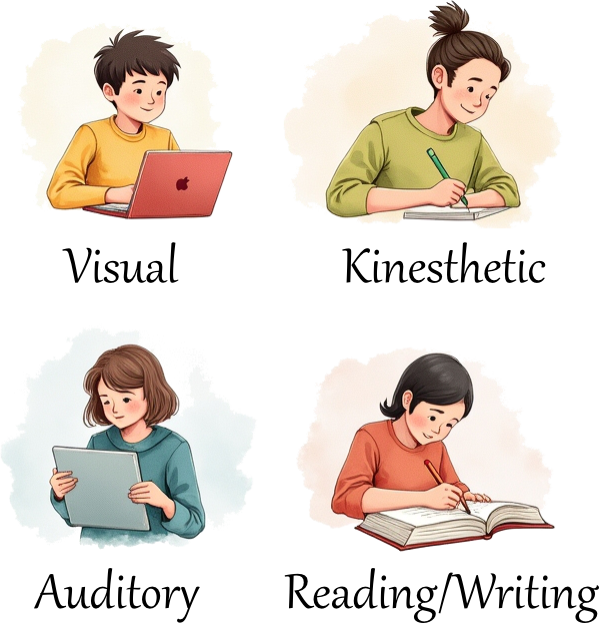
Every student engages with learning in different ways, and as an educator, incorporating varied teaching strategies can enhance comprehension and retention. While the idea of distinct learning styles (visual, auditory, kinesthetic, reading/writing) is widely discussed, research suggests that learning is more complex than fitting into one specific category. Rather than labeling students, using a mix of approaches can create a more inclusive and dynamic learning experience. In this post, we’ll explore practical ways to diversify lesson delivery to support all learners.
Why Using Varied Teaching Strategies Matters
A one-size-fits-all approach rarely works in the classroom. Incorporating multiple instructional methods allows you to:
- Improve student comprehension and engagement
- Foster a more inclusive learning environment
- Enhance lesson effectiveness and retention
- Encourage active participation
- Provide appropriate challenges for all students
- Encourage active participation
By making small but impactful changes, you can transform any lesson into an engaging experience that benefits all learners.
Understanding Different Ways Students Engage With Learning
While some students may gravitate toward specific learning methods, most benefit from a combination of approaches. Here are common ways students engage with content:
- Visual – images, charts, and spatial understanding
- Auditory – listening materials and verbal interactions
- Kinesthetic – hands-on activities and movement
- Reading/Writing – text-based learning and note-taking
Now, let’s explore how to adapt lesson plans for each learning preference.
How to Make Lessons More Engaging for All Learners
| Learning Style | Strategies |
|---|---|
| Visual Learners | – Use diagrams, charts, and infographics to explain concepts. – Incorporate videos or animations to demonstrate ideas. – Color-code notes and highlight key points. – Utilize slide presentations instead of plain text explanations. – Scaffold content by providing labeled visuals for beginners and more detailed diagrams for advanced students. |
| Auditory Learners | – Integrate group discussions and debates to encourage verbal expression. – Use audio recordings or podcasts to present information. – Encourage students to read aloud or explain concepts in their own words. – Provide rhymes or mnemonic devices to aid memory. – Scaffold content by allowing beginner students to repeat and listen, while advanced students engage in analytical discussions. |
| Kinesthetic Learners | – Incorporate hands-on activities such as experiments or role-playing. – Allow students to move around during learning (e.g., standing desks, walking discussions). – Use games and simulations to reinforce key concepts. – Provide opportunities for interactive digital tools and manipulatives. – Scaffold by offering structured movement-based activities for beginners and open-ended problem-solving tasks for advanced learners. |
| Reading/Writing Learners | – Assign written reflections, essays, or reports on lesson topics. – Encourage note-taking and journaling to reinforce learning. – Provide reading materials, case studies, or online articles. – Use worksheets and comprehension questions to test understanding. – Scaffold by simplifying texts for beginners and providing more complex readings for advanced learners. |
Ready-made lessons like those available from Teachers Together English take into consideration the needs of different learners and make it easy for you to differentiate your instruction as they offer a variety of activities for you to choose from.
Universal Design for Learning (UDL): A Holistic Approach
In addition to adapting lessons for different learning styles, Universal Design for Learning (UDL) provides a flexible framework that benefits all students, regardless of their learning preferences. UDL encourages designing lessons with multiple means of:
- Engagement: Offer choices in activities to match student interests and motivations.
- Representation: Present information in multiple formats, such as videos, text, and hands-on activities.
- Action & Expression: Allow students to demonstrate learning in different ways, such as presentations, projects, or written reports.
By incorporating UDL principles, educators create more inclusive lesson plans that support a wide range of learners. Learn more about UDL and how to integrate the principles into language instruction in the article Bringing Universal Design for Learning to the World Language Classroom by Katie Novak and Maureen Magnan.
Scaffolding Lessons for Mixed-Level Classrooms
Many educators use slide presentations to guide their lessons, but students in the classroom may have varying levels of English proficiency and comprehension. Here are ways to scaffold content effectively while using slides:
- Use Tiered Questions: Start with simple comprehension questions and gradually move to open-ended, analytical questions for more advanced students.
- Provide Sentence Stems: Offer beginners structured sentence starters to help them respond confidently.
- Incorporate Visual Cues: Use images, icons, and diagrams to support understanding for lower-level students while adding detailed captions for advanced learners.
- Offer Optional Extensions: Include extra challenge questions or activities on slides for students who need a higher level of difficulty.
- Encourage Peer Teaching: In a small group class, if using breakout rooms, pair stronger students with those who need additional support to explain key concepts in their own words.
- Slow Down or Speed Up as Needed: Allow struggling students time to process information while providing additional prompts or discussion points for those ready to move ahead.
By incorporating these scaffolding strategies, teachers can ensure all students remain engaged and challenged, regardless of their proficiency level.
Practical Example: Adapting a Lesson on Environmental Issues
Let’s say you’re teaching a lesson on climate change. Here’s how you can vary your teaching strategies and scaffold content:
- Visual: Show an infographic on carbon footprints and a short documentary. Beginners can label pictures, while advanced learners analyze trends.
- Auditory: Discuss the impact of climate change through a podcast or group debate. Provide key vocabulary for beginners and open-ended questions for advanced students.
- Kinesthetic: Have students create models of eco-friendly cities or conduct a recycling activity. Beginners follow step-by-step instructions, while advanced students design their own solutions.
- Reading/Writing: Assign a research paper on sustainable solutions. Beginners summarize key points, while advanced students critique sources and propose new ideas.
By integrating these adaptations into your lesson plan, you ensure every student can engage with the material in a way that suits them best. For more examples and strategies of how you can differentiate your lessons, check out this article by John McCarthy, 3 Ways to Plan for Diverse Learners: What Teachers Do.
Conclusion
While the concept of fixed learning styles is debated, providing a variety of teaching strategies can enhance student engagement and learning outcomes. By using a mix of visual, auditory, kinesthetic, and reading/writing approaches—and scaffolding content for different learning levels—you create a more flexible and inclusive classroom environment where all students can thrive.
What’s your favorite way to adapt lessons? Let us know in the comments!


Leave a Reply